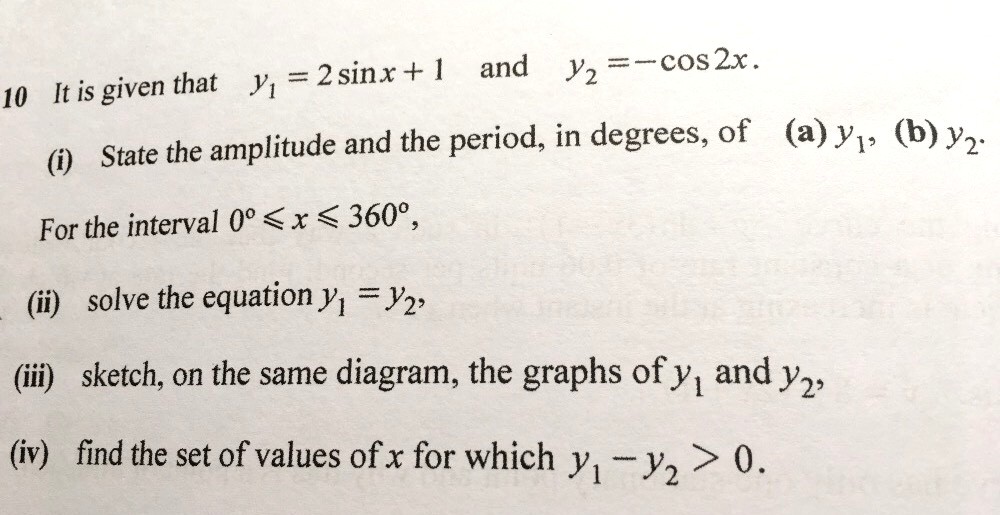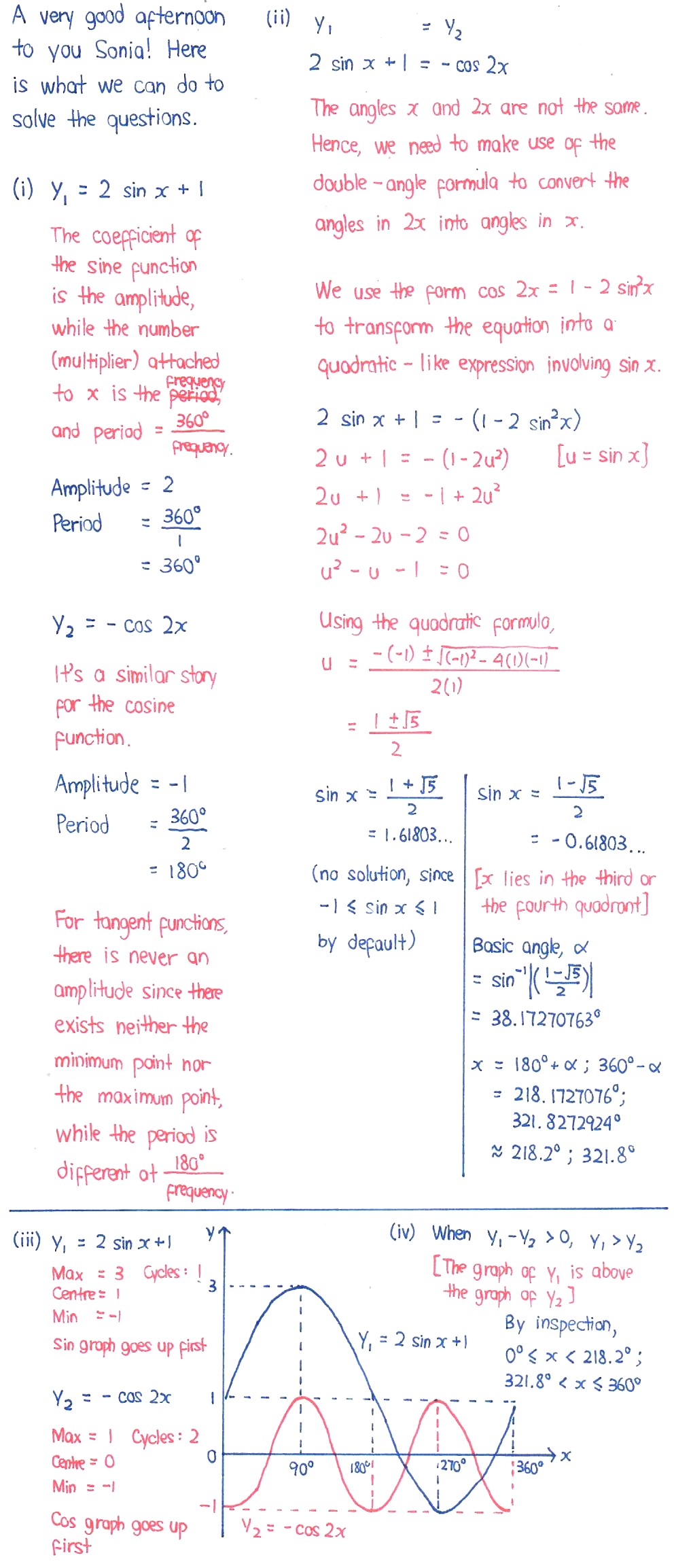Ask Singapore Homework?
Upload a photo of a Singapore homework and someone will email you the solution for free.

See 1 Answer
done
{{ upvoteCount }} Upvotes
clear
{{ downvoteCount * -1 }} Downvotes
Hi Sonia! Here are my workings and solutions to this question. For part (ii), we need to use the double-angle formula to solve this question. I have done the entire question for your reference so that you can compare your answers for the other three parts with my answers.
Let me know if you do not understand my workings or need more explanation and I will do my best to explain them in more detail!
Let me know if you do not understand my workings or need more explanation and I will do my best to explain them in more detail!
Date Posted:
4 years ago
Thank you so much Eric! i truly appreciate it.
May i ask 2 questions?
The first question would be, can an amplitude be negative? As some answers says it can’t be negative..
And my second question would be for the y1-y2 part..
Can i say that the solutions to it would be the intersections of the 2 graphs?
May i ask 2 questions?
The first question would be, can an amplitude be negative? As some answers says it can’t be negative..
And my second question would be for the y1-y2 part..
Can i say that the solutions to it would be the intersections of the 2 graphs?
Good evening Sonia!
Amplitudes, in general, are defined to be distances from the centre point to the minimum or maximum of the function. This corresponds to half the distance between the minimum and the maximum.
In reality, because amplitudes are technically lengths, they cannot be negative. However, I have decided to count them in instead.
The negative sign attached to the otherwise positive coefficient just simply means that the graph is going the other way. A graph of cos 2x starts from the top and goes down; a graph of - cos 2x, on the other hand, starts from the bottom first and goes up.
Similarly, a graph of sin x starts at the centre and goes up first, while the graph of - sin x starts at the centre and goes down first.
So in short, the negative sign just indicates the initial direction of the graph. Strictly speaking, amplitudes should be a positive number just like lengths, for example, but I believe that negatives should be alright as an answer. Because if we call 1 the amplitude and 180 degrees the period, then the negative sign in front of the amplitude would not have a name to it.
For the y1 - y2 part, the points of intersection of the two graphs correspond to the situation where y1 = y2, not exactly the > case or the < case. These are the boundary values which control the solutions. y1 > y2 simply indicates that y1 is more than, or above, y2 (but the boundary values are still needed), while y1 < y2 indicates that y1 is less than, or below, y2.
This is similar to solving inequalities, where 2x - 1 = 3 corresponds to the point where the line y = 2x - 1 intersects the horizontal line y = 3, of which the solution is x = 2. For solving 2x - 3 > 1, we are looking for regions where y = 2x - 1 is above y = 3, and this is where x > 2. The "x = 2" solution is still needed here as a boundary value for the inequality, just that instead of =, it's >.
Hope this helps! Sorry for the lengthy explanation.
Amplitudes, in general, are defined to be distances from the centre point to the minimum or maximum of the function. This corresponds to half the distance between the minimum and the maximum.
In reality, because amplitudes are technically lengths, they cannot be negative. However, I have decided to count them in instead.
The negative sign attached to the otherwise positive coefficient just simply means that the graph is going the other way. A graph of cos 2x starts from the top and goes down; a graph of - cos 2x, on the other hand, starts from the bottom first and goes up.
Similarly, a graph of sin x starts at the centre and goes up first, while the graph of - sin x starts at the centre and goes down first.
So in short, the negative sign just indicates the initial direction of the graph. Strictly speaking, amplitudes should be a positive number just like lengths, for example, but I believe that negatives should be alright as an answer. Because if we call 1 the amplitude and 180 degrees the period, then the negative sign in front of the amplitude would not have a name to it.
For the y1 - y2 part, the points of intersection of the two graphs correspond to the situation where y1 = y2, not exactly the > case or the < case. These are the boundary values which control the solutions. y1 > y2 simply indicates that y1 is more than, or above, y2 (but the boundary values are still needed), while y1 < y2 indicates that y1 is less than, or below, y2.
This is similar to solving inequalities, where 2x - 1 = 3 corresponds to the point where the line y = 2x - 1 intersects the horizontal line y = 3, of which the solution is x = 2. For solving 2x - 3 > 1, we are looking for regions where y = 2x - 1 is above y = 3, and this is where x > 2. The "x = 2" solution is still needed here as a boundary value for the inequality, just that instead of =, it's >.
Hope this helps! Sorry for the lengthy explanation.
Thank you so much for this explanation, i understand it thoroughly!
You may think of it this way. I believe you have heard of limiting reagents and excess reagents in chemistry.
Suppose 1 mole of NaOH reacts with 2 moles of H2SO4 (it actually is, in theory).
Given 4 moles of NaOH is present, we would need 8 moles of H2SO4 to neutralise the NaOH fully.
So "x = 8" is the limit here for equality.
If "x < 8" (x = 8 is the boundary limit), there would not be enough H2SO4 for complete neutralisation, so "NaOH > H2SO4".
Similarly, if "x > 8", there would be too much H2SO4 present, leaving H2SO4 in excess, so "H2SO4 > NaOH".
Suppose 1 mole of NaOH reacts with 2 moles of H2SO4 (it actually is, in theory).
Given 4 moles of NaOH is present, we would need 8 moles of H2SO4 to neutralise the NaOH fully.
So "x = 8" is the limit here for equality.
If "x < 8" (x = 8 is the boundary limit), there would not be enough H2SO4 for complete neutralisation, so "NaOH > H2SO4".
Similarly, if "x > 8", there would be too much H2SO4 present, leaving H2SO4 in excess, so "H2SO4 > NaOH".





